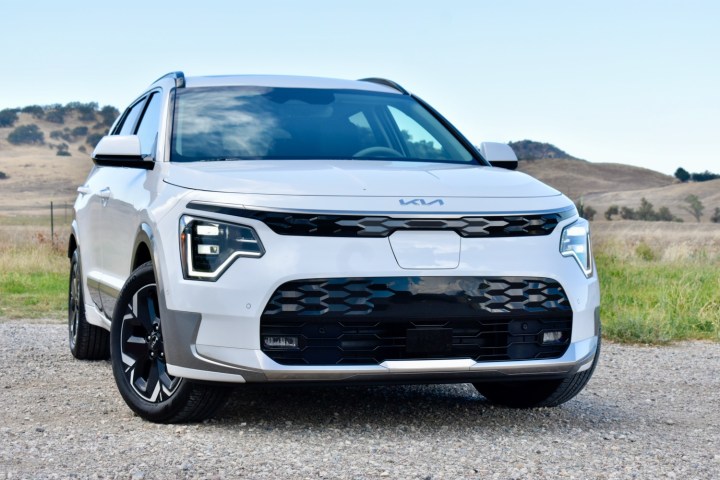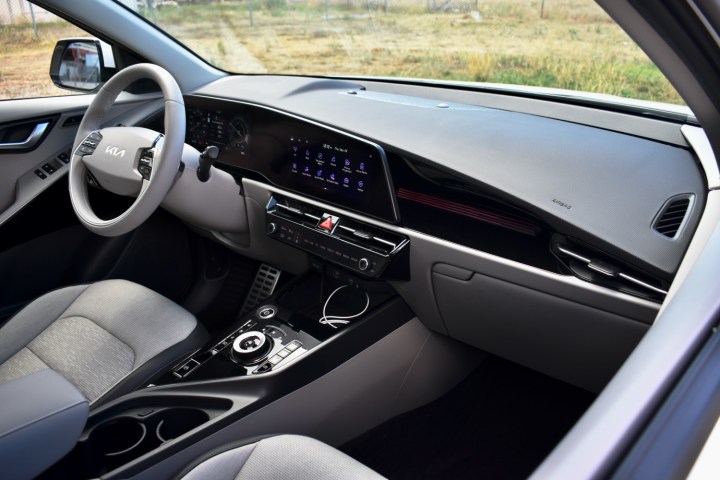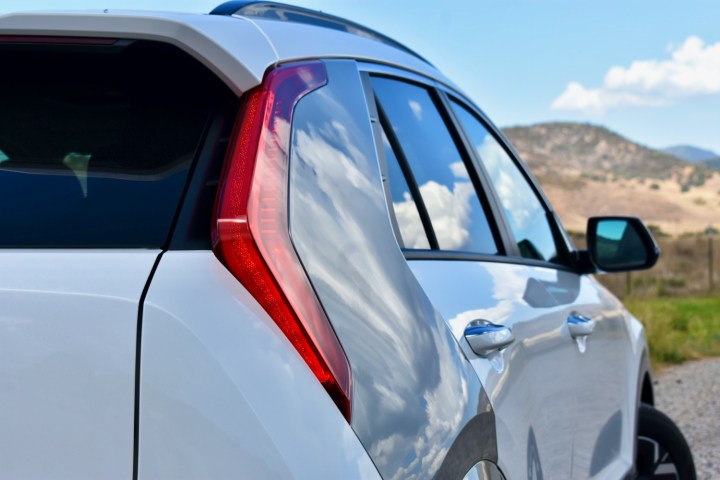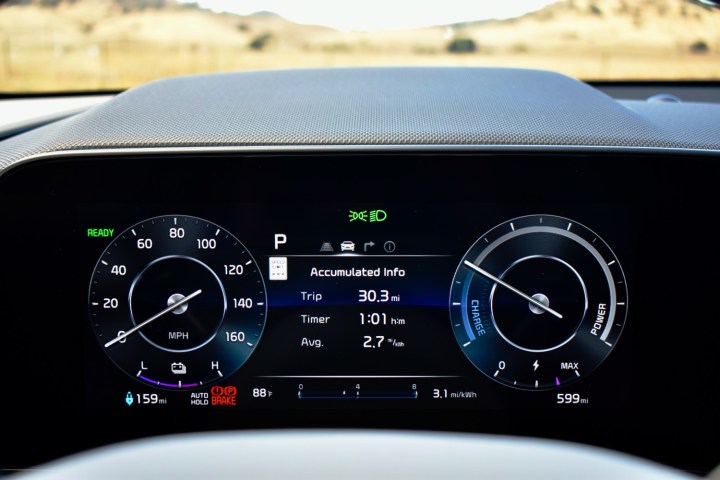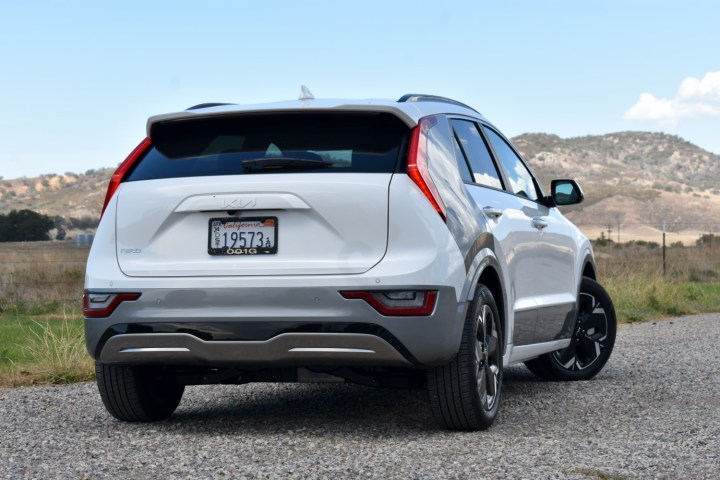If you want to see just how quickly the electric car landscape has changed over the past few years, take a look at the redesigned 2023 Kia Niro EV.
When the first-generation Niro EV launched for the 2019 model year (following hybrid and plug-in hybrid Niro variants), it was a pretty big deal. The Niro was Kia’s first EV not based on a conventional gasoline model, and the first intended for high sales volumes.
The second-generation 2023 Niro EV boasts more tech, more space, and more extroverted styling than its predecessor, but it’s still very much in the shadow of the Kia EV6. Once Kia’s main EV attraction, the Niro is being refocused as a more affordable option to take on the likes of the Chevrolet Bolt EV/Bolt EUV, Volkswagen ID.4, and Nissan Leaf.
Kia plans to offer the Niro EV in trim levels named Wind and Wave, but hasn’t released pricing for either. Note that the previous-generation 2022 Niro EV started at $41,245; the new model could see a price increase because of its updates. And because it’s assembled in South Korea, the 2023 Niro EV won’t qualify for the revamped federal EV tax credit, Kia has confirmed.
Design and interior
Like the previous generation, the Niro is part of a three-pronged lineup that also includes the Niro Hybrid and Niro PHEV (plug-in hybrid models). All three maintain the tall-wagon shape of the first-generation Niro, but with much bolder styling.
Where the previous Niro was a wishy-washy mix of car and SUV styling elements, the 2023 Niro is the result of the same fearless design department that produced the EV6 and the 2023 Kia Sportage. The traditional automotive “face” was rearranged with a visor-like element, protruding grille, and hexagonal lighting elements. Contrasting trim panels break up the profile view, and conceal “Air Blade” elements around the taillights that, Kia claims, reduce aerodynamic drag.
Kia used sustainable materials to further decrease the Niro EV’s environmental impact.
Kia also got creative with the interior design, opting for lots of curved surfaces that blend together to create a nice visual flow between the dashboard and door panels. The dashboard screens are also well integrated, so it doesn’t look like designers simply nailed some iPads to the dash, as in some other cars. Kia also claims the interior is 100% vegan, and uses sustainable materials like recycled wallpaper (in the headliner) and eucalyptus leaves (in the seats) to further decrease the Niro EV’s environmental impact.
The redesigned Niro EV is 2.5 inches longer than the previous-generation model, and its wheelbase grew 0.8 inches to 107.1 inches total. That translates to a fairly compact vehicle with generous interior space for its size. The Kia has more headroom and legroom in both rows than a Chevy Bolt EUV or Nissan Leaf, albeit less than the VW ID.4. Similarly, the Niro EV’s 22.8 cubic feet of cargo space with the rear seats up and 63.7 cubic feet with the back seats folded beat the Chevy and Nissan, but are behind the VW.
Tech, infotainment, and driver-assist
The standard infotainment system includes a 10.25-inch touchscreen and 10.25-inch digital instrument cluster in the same housing to create the appearance of one continuous screen. Wired Apple CarPlay and Android Auto are also standard (Kia doesn’t offer wireless versions with this touchscreen), along with wireless phone charging. The complement of USB ports includes one USB-C and two USB-A ports for the front seats, and a pair of seatback-mounted USB-A ports for rear-seat passengers.
The lack of wireless Apple CarPlay and Android Auto is inconvenient, but the front USB ports and phone tray are at least well-placed for plugging in. The infotainment system itself was also easy to use, with a quick-responding touchscreen and sensible menu layouts.
Safety features include forward collision warning (with pedestrian detection), automatic emergency braking, lane keep assist, a driver attention monitor, rear cross traffic alert, safe exit warning, and rear occupant alert standard equipment, as well as blind spot collision avoidance for pulling out of parallel parking spaces.
The infotainment system was easy to use, with a responsive touchscreen and sensible layout.
Adaptive cruise control is standard as well, with stop-and-go functionality and navigation-based curve prediction, which standard systems from the likes of Honda and Toyota don’t have. Kia’s Highway Driving Assist II system, which adds automated lane centering for highway driving, is also available and boasts a machine-learning function that adapts the system’s responses to your driving style, Kia claims.
With its ability to control acceleration, braking, and steering while still requiring drivers to keep their hands on the wheel, Highway Driving Assist II roughly matches the capability of the ProPilot Assist system available on the Nissan Leaf and the VW ID.4’s available Travel Assist system. But the Chevy Bolt EUV can be equipped with Super Cruise, which allows for hands-free driving on designated stretches of highway (that system isn’t available on the Bolt EV, however).
The Niro EV is also available with the Digital Key system previously seen on other Kia models and those of related brands Hyundai and Genesis. Digital Key lets drivers use a smartphone or other device in place of the key fob, although, in the Niro EV, it only works with iPhones, the Apple Watch, and Samsung Galaxy phones for now.
Driving experience
The Niro EV has more power than other Niro variants. Its single electric motor sends 201 horsepower and 188 pound-feet of torque to the front wheels, compared to 139 hp and 195 lb.-ft. of torque for the Niro Hybrid and 180 hp and 195 lb.-ft. for the Niro PHEV (those versions are front-wheel drive as well). A 64.8-kilowatt-hour battery pack provides the juice.
Kia says the Niro EV will do zero to 62 mph in 7.8 seconds — quicker than the hybrid and plug-in hybrid models, but not exactly noteworthy. Unlike the EV6, the Niro EV doesn’t make any pretenses of sportiness. And it felt plenty quick for an ordinary car in real-world traffic, anyway.
The Niro EV doesn’t make any pretensions of sportiness.
The Niro EV’s chassis felt ordinary as well. The Kia didn’t go beyond its station in ride quality, and it wasn’t much fun on twisty roads, but it didn’t have any real issues either. We think it would make a perfectly satisfying daily driver — but don’t expect anything more than that.
Like other electric cars, the Niro EV uses regenerative braking to harvest energy under deceleration. Kia provides multiple levels of regeneration, which can be adjusted with steering wheel paddles, along with an automatic mode called i-Pedal. This is supposed to choose the most efficient setting and will dial back regeneration at times when coasting is deemed better. While that sounds good in theory, this can also leave the driver guessing about how much regeneration they will get, and whether or not they will need to use the brake pedal to slow the car.
Range, charging, and safety
Official range and efficiency ratings for the Niro EV haven’t been released yet, but Kia is aiming for 253 miles. That would put the Niro in the same ballpark as the 259-mile Chevy Bolt EV and 247-mile Bolt EUV without outshining the Niro’s Kia EV6 sibling, which surpasses 300 miles in some configurations. An optional heat pump and battery warmer should help preserve range in cold temperatures.
The Niro EV can DC fast charge, but only at 85 kilowatts. That means it takes an estimated 45 minutes to go from a 10% to an 80% charge, which isn’t great considering that many EVs can do the same in around 20 minutes. The Niro EV charges at 11 kW from a Level 2 AC source, requiring seven hours for a full recharge. That’s closer to average, at least, and the Niro EV can also power your devices thanks to built-in vehicle-to-load (V2L) capability, which draws power from the battery pack.
The Insurance Institute for Highway Safety (IIHS) and National Highway Traffic Safety Administration (NHTSA) haven’t released crash-test ratings for the 2023 Niro EV or its hybrid and plug-in hybrid siblings.
Like other Kias, the Niro EV gets an impressive 10-year, 100,000-mile powertrain warranty and five-year, 60,000-mile limited warranty.
How DT would configure this car
There isn’t too much difference between the Niro EV Wind and Wave trim levels, but the high-end Wave model does have Remote Smart Parking Assist and the inverter that allows for V2L power output, as well as some added convenience features like a power front passenger’s seat, ventilated front seats (heated front seats are standard on both models), and a memory system for seat settings. Highway Driving Assist II is also available on the Wave model, but as an extra-cost option. So if you want the most tech content, that’s the one to go for.
While styling is subjective, we feel the Niro EV stands out visually, and Kia’s effort to use sustainable interior materials is noteworthy. The Niro EV also offers a decent amount of interior space for its size, and a respectable amount of range. That should make for a good companion to the EV6 in Kia’s lineup, but not a world-beater.
The EV competition has grown since the Kia Niro EV first appeared. The Chevy Bolt EUV is more fun to drive and is available with the more sophisticated Super Cruise hands-free driver-assist system, while the VW ID.4 offers up to 275 miles of range in certain configurations and is available with all-wheel drive. The Hyundai Kona Electric offers many of the same tech features as the Niro, with a 258-mile range, although it’s unclear how long it will stick around. While still pretty far out, the 2024 Chevy Equinox EV’s $30,000 base price and more traditional SUV packaging could undercut the Niro EV’s value argument going forward.
So while the Niro EV is an appealing electric car, it’s not the only one. That’s great for EV buyers, but perhaps not for Kia.
